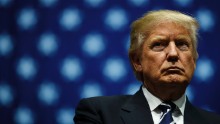Electors remain faithful to Trump and select him as official winner
Donald Trump surpassed the necessary 270 votes in the Electoral College on Monday, taking the next step in the official process to become President.
Trump received 304 electoral votes to Hillary Clinton's 227. Seven "faithless" electors voted for other candidates, costing Trump two votes and Clinton four. Hawaii's votes -- three for Clinton and one breaking from the state's results and supporting Bernie Sanders -- were the last to be counted.
The results mean Trump -- who lost the popular vote by more than 2 percentage points to Clinton -- easily staved off a long-shot bid by opponents to turn Republican electors against him.
The Electoral College results will be officially certified January 6 during a joint session of Congress.
"This election represents a movement that millions of hard working men and women all across the country stood behind and made possible. With this historic step we can look forward to the bright future ahead. I will work hard to unite our country and be the president of all Americans. Together, we will make America great again," Trump said in a statement.
He also claimed his win was "a historic electoral landslide victory in our nation's democracy," though Clinton actually won the popular vote by about 3 million ballots nationwide making Trump the worst-performing winner in the popular vote since 1876.
Trump was put over the top by electors in Texas. Thirty-six of the state's 38 went for Trump, while two ignored the state's Election Day results. One voted for Ohio Gov. John Kasich and one backed former Texas Rep. Ron Paul.
The first response from Trump's camp came from Vice President-elect Mike Pence, who tweeted: "Congratulations to @RealDonaldTrump; officially elected President of the United States today by the Electoral College!"
Pence also wrote, "I'm honored & humbled to be officially elected today as the next Vice President of the United States of America by the Electoral College."
In Washington state, four electors opted for other candidates, instead of backing Hillary Clinton. Three cast ballots for former Secretary of State Colin Powell, and one backed Faith Spotted Eagle, a Native American activist who's been involved in the North Dakota pipeline fight.
Those Washington electors also picked a mixed bag for the vice presidency. One voted for home-state Sen. Maria Cantwell. Massachusetts Sen. Elizabeth Warren and Republican Sen. Susan Collins of Maine each got votes, as well. And one went to activist Winona LaDuke, Ralph Nader's running mate as the 2000 Green Party nominee for vice president.
This is the first US presidential election since 1872 with more than one "faithless elector."
When all the votes were counted in November, the President-elect won 306 electoral votes to Clinton's 232. Some have since called on electors to vote against their state results, after Hillary Clinton won the popular vote by nearly 3 million ballots nationwide.
The 538 men and women voted primarily in accordance with the results from November in their state. The electors, chosen by state parties of the candidate who carried each state, convened in all 50 state capitals and the District of Columbia.
While electors are technically chosen to independently cast their ballots for president, both precedent and, in most cases, state laws require them to abide by the people's vote in each state.
After a fraught election, some have called on electors to vote against their state results.
In Minnesota, one elector was disqualified after declaring he would vote for someone other than his state's winner, Clinton. Under state law, he was replaced, and the alternate voted for Clinton.
Protests had popped up around the country Monday as frustrated Americans sought one last opportunity to stop the candidate they opposed.
From immigrant to elector: 'Living the American Dream'
But mass defections of electors was always extremely unlikely.
Thirty-seven of Trump's pledged 306 electors would have had to vote against him, becoming so-called "faithless electors," to keep him under the 270 threshold to become President. If Clinton were to reach 270 in that far-fetched scenario, she could have become President. If no candidate reached 270, the House of Representatives would have held a vote when Congress reconvenes in January.
There have been a handful faithless electors in past cycles, though never enough to change the outcome of the race.
Ohio Secretary of State Jon Husted, whose state was won by Trump, tweeted a picture of the ballot for electors in his state. It featured a ballot for Trump as President and Mike Pence as vice president.
News Courtesy: www.cnn.com











